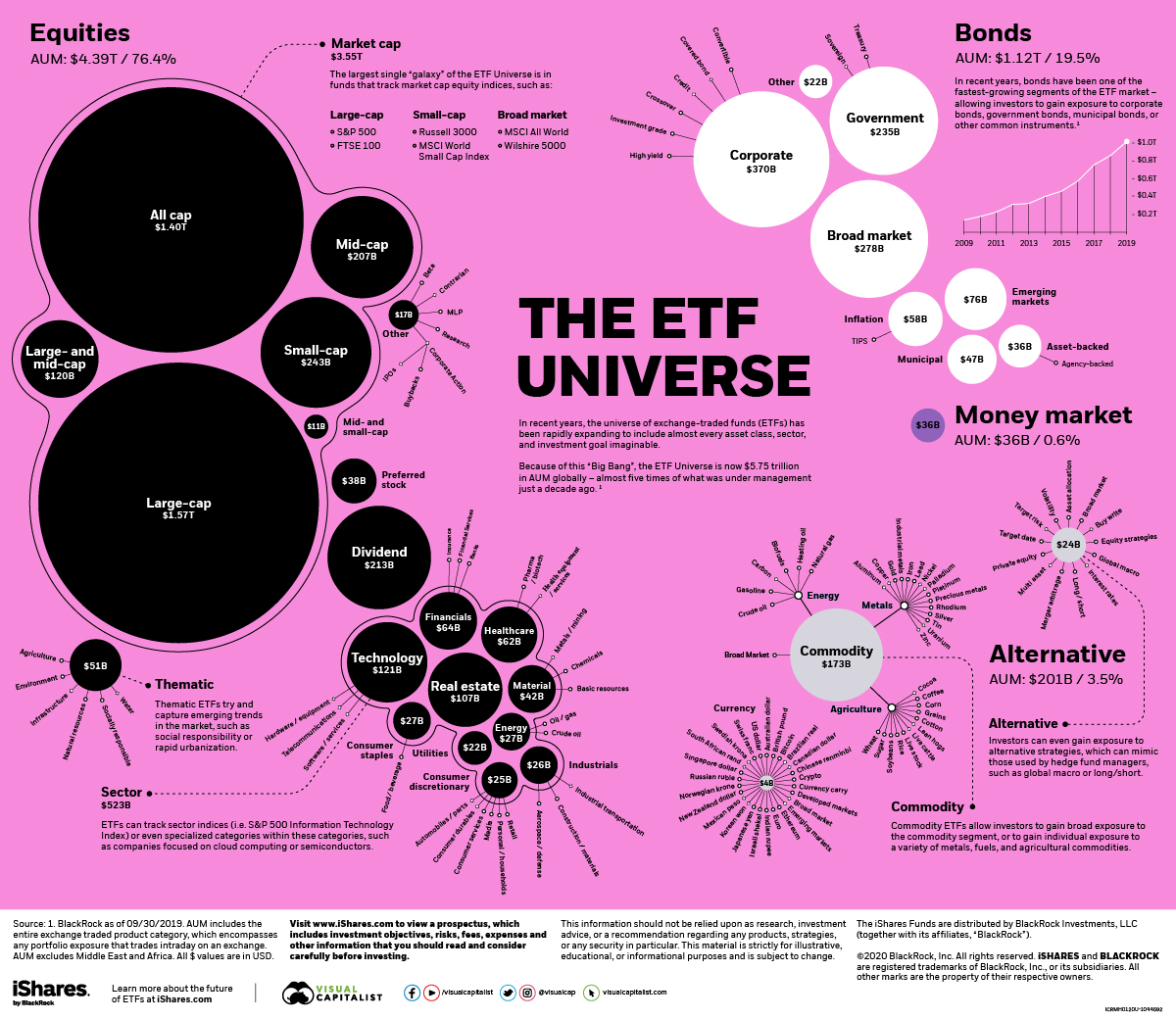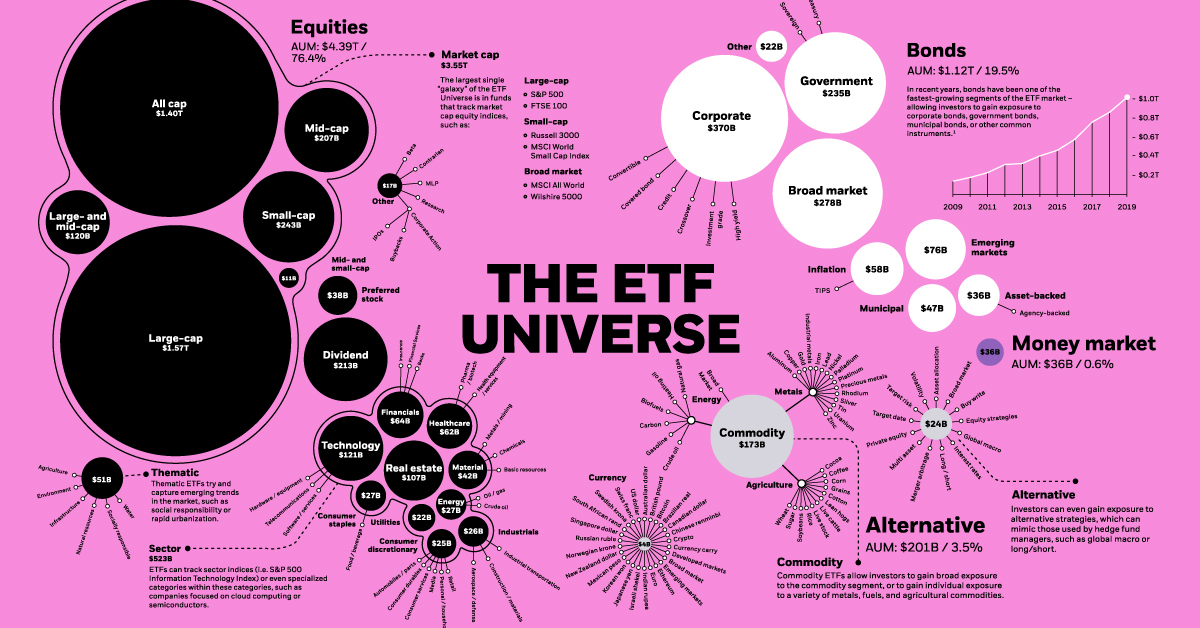Markets
Visualizing the Expanse of the ETF Universe
View the full-size version of this infographic.
Visualizing the Expanse of the ETF Universe
View the high resolution version of this infographic by clicking here.
Under the right circumstances, an innovation can scale and flourish.
Within the financial realm, there is perhaps no better example of this than the introduction of exchange-traded funds (ETFs), a new financial technology that emerged out of the index investing phenomenon of the early 1990s.
Since the establishment of the first U.S. ETF in 1993, the financial instrument has gained broad traction — and today, the ETF universe has an astonishing $5.75 trillion in assets under management (AUM), covering almost every niche imaginable.
Navigating the ETF Universe
Today’s data visualization comes to us from iShares by BlackRock, and it visualizes the wide scope of assets covered by the ETF universe.
To start, let’s look at a macro breakdown of the “galaxies” that can be found in the universe:
| Global ETFs (AUM, $USD) | Share of Global Total | |
|---|---|---|
| Equities | $4.39 trillion | 76.4% |
| Bonds | $1.12 trillion | 19.5% |
| Alternative | $0.20 trillion | 3.5% |
| Money market | $0.04 trillion | 0.6% |
| All ETFs | $5.75 trillion | 100.00% |
As you can see, equities are by far the largest galaxy in the ETF universe, making up 76.4% of all assets. These clusters likely comprise the ETFs you are most familiar with — for example, funds that track the S&P 500 index or foreign markets.
That said, it’s worth noting that the fastest expanding galaxy is bond ETFs, tracking indices related to the debt issued by governments and corporations. The first bond ETFs were introduced in 2002, and since then the category has grown into a market that exceeds $1 trillion in AUM. Bond ETFs are expected to surpass the $2 trillion mark by 2024.
Everything Under the Sun
While the sheer scale of the ETF universe is captivating, it’s the variety that shows you how ubiquitous the instrument has become.
Today, there are over 8,000 ETFs globally, covering nearly every asset class imaginable. Here are some of the lesser-known and more peculiar corners in the ETF universe:
Thematic ETFs: Gaining popularity in recent years, thematic ETFs are built around long-term trends such as climate change or rapid urbanization. By having more tangible focus points, these funds can also appeal to younger generations of investors.
Contrarian ETFs: In a healthy market, there can be a variety of different positions being taken by investors. Contrarian ETFs help to make this possible, allowing investors to bet against the “herd”.
Factor-based ETFs: This approach uses a rules-based system for selecting investments in the fund portfolio, based on factors typically associated with higher returns such as value, small-caps, momentum, low volatility, quality, or yield.
Global Macro ETFs: Some ETFs are designed to mimic strategies used by hedge fund managers. One example of such a strategy is global macro, which aims to analyze the macroeconomic environment, while taking corresponding long and short positions in various equity, fixed income, currency, commodities, and futures markets.
Commodity ETFs: There are ETFs that track gold or oil, sometimes even storing physical inventories. Interestingly, however, there are commodity ETFs for even more obscure metals and agricultural products, such as zinc, lean hogs, tin, or cocoa beans.
Whether your investments track popular market indices or you are more surgical about your portfolio exposure, the ETF universe is impressively vast — and it’s projected to keep expanding in size and diversity for years to come.
Economy
Economic Growth Forecasts for G7 and BRICS Countries in 2024
The IMF has released its economic growth forecasts for 2024. How do the G7 and BRICS countries compare?

G7 & BRICS Real GDP Growth Forecasts for 2024
The International Monetary Fund’s (IMF) has released its real gross domestic product (GDP) growth forecasts for 2024, and while global growth is projected to stay steady at 3.2%, various major nations are seeing declining forecasts.
This chart visualizes the 2024 real GDP growth forecasts using data from the IMF’s 2024 World Economic Outlook for G7 and BRICS member nations along with Saudi Arabia, which is still considering an invitation to join the bloc.
Get the Key Insights of the IMF’s World Economic Outlook
Want a visual breakdown of the insights from the IMF’s 2024 World Economic Outlook report?
This visual is part of a special dispatch of the key takeaways exclusively for VC+ members.
Get the full dispatch of charts by signing up to VC+.
Mixed Economic Growth Prospects for Major Nations in 2024
Economic growth projections by the IMF for major nations are mixed, with the majority of G7 and BRICS countries forecasted to have slower growth in 2024 compared to 2023.
Only three BRICS-invited or member countries, Saudi Arabia, the UAE, and South Africa, have higher projected real GDP growth rates in 2024 than last year.
| Group | Country | Real GDP Growth (2023) | Real GDP Growth (2024P) |
|---|---|---|---|
| G7 | 🇺🇸 U.S. | 2.5% | 2.7% |
| G7 | 🇨🇦 Canada | 1.1% | 1.2% |
| G7 | 🇯🇵 Japan | 1.9% | 0.9% |
| G7 | 🇫🇷 France | 0.9% | 0.7% |
| G7 | 🇮🇹 Italy | 0.9% | 0.7% |
| G7 | 🇬🇧 UK | 0.1% | 0.5% |
| G7 | 🇩🇪 Germany | -0.3% | 0.2% |
| BRICS | 🇮🇳 India | 7.8% | 6.8% |
| BRICS | 🇨🇳 China | 5.2% | 4.6% |
| BRICS | 🇦🇪 UAE | 3.4% | 3.5% |
| BRICS | 🇮🇷 Iran | 4.7% | 3.3% |
| BRICS | 🇷🇺 Russia | 3.6% | 3.2% |
| BRICS | 🇪🇬 Egypt | 3.8% | 3.0% |
| BRICS-invited | 🇸🇦 Saudi Arabia | -0.8% | 2.6% |
| BRICS | 🇧🇷 Brazil | 2.9% | 2.2% |
| BRICS | 🇿🇦 South Africa | 0.6% | 0.9% |
| BRICS | 🇪🇹 Ethiopia | 7.2% | 6.2% |
| 🌍 World | 3.2% | 3.2% |
China and India are forecasted to maintain relatively high growth rates in 2024 at 4.6% and 6.8% respectively, but compared to the previous year, China is growing 0.6 percentage points slower while India is an entire percentage point slower.
On the other hand, four G7 nations are set to grow faster than last year, which includes Germany making its comeback from its negative real GDP growth of -0.3% in 2023.
Faster Growth for BRICS than G7 Nations
Despite mostly lower growth forecasts in 2024 compared to 2023, BRICS nations still have a significantly higher average growth forecast at 3.6% compared to the G7 average of 1%.
While the G7 countries’ combined GDP is around $15 trillion greater than the BRICS nations, with continued higher growth rates and the potential to add more members, BRICS looks likely to overtake the G7 in economic size within two decades.
BRICS Expansion Stutters Before October 2024 Summit
BRICS’ recent expansion has stuttered slightly, as Argentina’s newly-elected president Javier Milei declined its invitation and Saudi Arabia clarified that the country is still considering its invitation and has not joined BRICS yet.
Even with these initial growing pains, South Africa’s Foreign Minister Naledi Pandor told reporters in February that 34 different countries have submitted applications to join the growing BRICS bloc.
Any changes to the group are likely to be announced leading up to or at the 2024 BRICS summit which takes place October 22-24 in Kazan, Russia.
Get the Full Analysis of the IMF’s Outlook on VC+
This visual is part of an exclusive special dispatch for VC+ members which breaks down the key takeaways from the IMF’s 2024 World Economic Outlook.
For the full set of charts and analysis, sign up for VC+.
-

 Markets1 week ago
Markets1 week agoU.S. Debt Interest Payments Reach $1 Trillion
-

 Business2 weeks ago
Business2 weeks agoCharted: Big Four Market Share by S&P 500 Audits
-

 Real Estate2 weeks ago
Real Estate2 weeks agoRanked: The Most Valuable Housing Markets in America
-

 Money2 weeks ago
Money2 weeks agoWhich States Have the Highest Minimum Wage in America?
-

 AI2 weeks ago
AI2 weeks agoRanked: Semiconductor Companies by Industry Revenue Share
-

 Markets2 weeks ago
Markets2 weeks agoRanked: The World’s Top Flight Routes, by Revenue
-

 Demographics2 weeks ago
Demographics2 weeks agoPopulation Projections: The World’s 6 Largest Countries in 2075
-

 Markets2 weeks ago
Markets2 weeks agoThe Top 10 States by Real GDP Growth in 2023
















